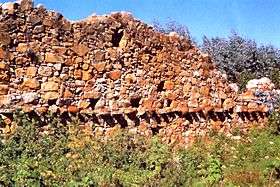Viracochapampa
Viracochapampa[1][2][3][4][5], Huiracochapampa, or Wiracochapampa[6][7] (possibly from Quechua wiraqucha: mister, sir, gentleman, god; or Wiracocha: one of the greatest Andean divinities; and pampa: plain)[8] is an archaeological site with the remains of a building complex of ancient Peru of pre-Inca times. It was one of the administrative centers of the Wari culture. Viracochapampa is located about 3.5 km north of Huamachuco in the region of La Libertad at an elevation of 3,070 metres (10,072 ft).
 Wall in Wiracochapampa | |
 Shown within Peru | |
| Alternative name | Wiracochapampa |
|---|---|
| Location | Huamachuco, La Libertad |
| Coordinates | 7°47′15.6″S 78°02′47.4″W |
| History | |
| Periods | Middle Horizon |
| Cultures | Wari culture |
Chronology
The site was occupied from the late Middle Horizon 1B time to the first decades of period 2A, according to the chronology established by Dorothy Menzel, taking as reference the classic division of Horizons and Intermediate by John Rowe. These correspond to the 7th and 8th centuries of our era.
See also
- Marcahuamachuco
- Chimu
- Mochica
- Trujillo
References
- Quilter, Jeffrey (2013). The Ancient Central Andes. Routledge. pp. 222–223. ISBN 9781317935230.
- Peru 1:100 000, Cajabamba (16-g). IGN (Instituto Geográfico Nacional - Perú).
- Quilter, Jeffrey (2012). The Civilization of the Incas. The Rosen Publishing Group. p. 114. ISBN 9781448885053.
- Isbell, William Harris; McEwan, Gordon Francis; Oaks, Dumbarton (1991). Huari Administrative Structure: Prehistoric Monumental Architecture and State Government. Dumbarton Oaks. pp. 141–153. ISBN 9780884021865.
- Silverman, Helaine; Isbell, William (2008). Handbook of South American Archaeology. Springer Science & Business Media. pp. 742–766. ISBN 9780387749075.
- "SITIO ARQUEOLÓGICO WIRACOCHAPAMPA". Inventario Turístico de Perú. MINCETUR. Retrieved 2017-05-29.
- Box, Ben; Murphy, Alan (2001). Peru Handbook: The Travel Guide. Footprint. p. 434. ISBN 9781900949842.
- Teofilo Laime Ajacopa, Diccionario Bilingüe Iskay simipi yuyayk'ancha, La Paz, 2007 (Quechua-Spanish dictionary), p. 136 (see wiraqucha) and p. 209 (see wiracocha)
Further reading
- Denise Pozzi–Escot Buenano: Historia del Perú III. El Perú Antiguo III (500-1400) El Horizonte Medio y los estados regionales, Empresa Editora El Comercio S.A., Lima, 2010. ISBN 978-612-4069-88-8
- Kauffmann Doig, Federico: Historia y arte del Perú antiguo. Tomo 3. Lima, Ediciones PEISA, 2002. ISBN 9972-40-215-0
- Lumbreras, Luis Guillermo: “El Imperio Wari”. Incluido en Historia del Perú. Tomo II. Perú Antiguo. Lima, Editorial Juan Mejía Baca, 1980.
- Makowski, Krzysztof: "Primeras civilizaciones," Enciclopedia Temática del Perú, Tomo 2. Lima, Empresa Editora “El Comercio” S.A., 2004. ISBN 9972-217-17-5
- Santillana, Julián I.: «Los estados panandinos: Wari y Tiwanaku». Incluida en Historia del Perú. Lexus Editores. Barcelona, 2000. ISBN 9972-625-35-4
- Tauro del Pino, Alberto: Enciclopedia Ilustrada del Perú,Tercera Edición. Tomo 17. VAC/ZUZ. Lima, PEISA, 2001. ISBN 9972-40-166-9